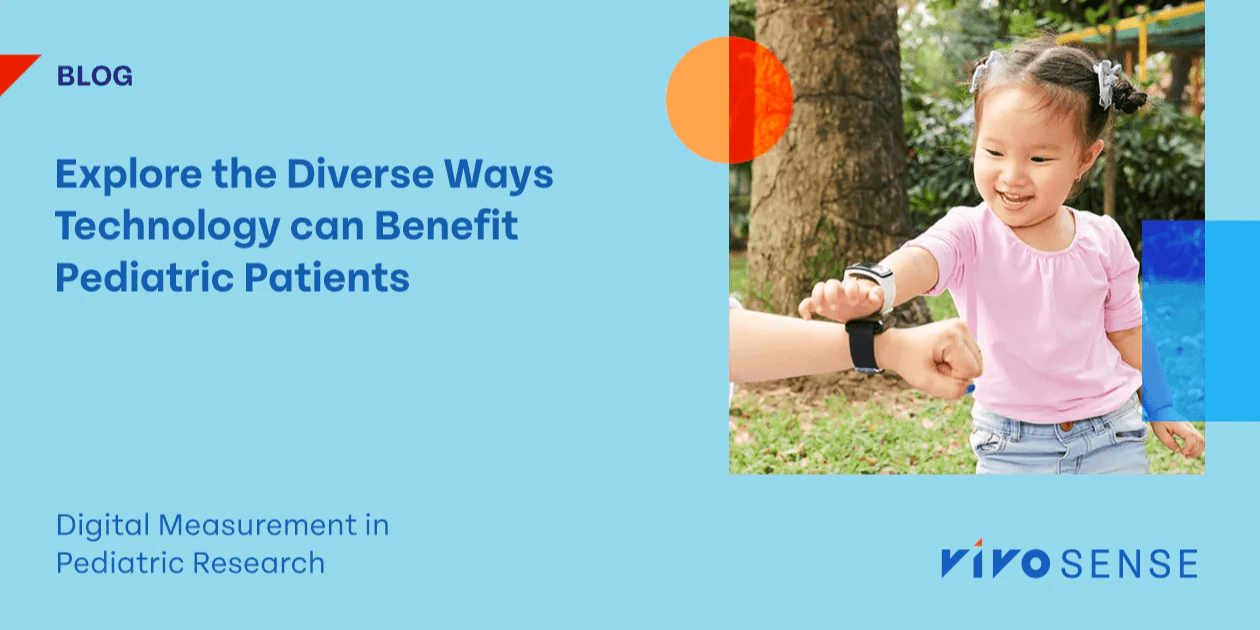
In May 2022, UCB launched a digital health roundtable series to explore the many diverse ways technology can benefit patients. In the third Roundtable, Emily Lewis (Digital Business Transformation, Neurology, UCB) convened an expert panel, including Dudley Tabakin, VivoSense CEO, to discuss the field of pediatric digital measurement to unpack key learnings from deployments to date, challenges, opportunities and the need for its translation into care. Watch the full video to hear insights from all four esteemed panelists.

Discussion Highlights
The following excerpts are insights and ideas Dudley Tabakin, VivoSense CEO, shared during the conversation.
DHTs: Adults vs. Children
Emily Lewis: There are many examples of digital health tools being deployed in adults, but very few examples of these tools being deployed in children. How do you believe the measurement process fundamentally differs between children and adults?
Dudley Tabakin: We’ve worked in pediatric rare disease in spinal muscular atrophy and Rett syndrome. In rare diseases in the pediatric population, measuring outcomes with subjective measure is much more complicated than in an adult population. You can ask adults how they are feeling, and they can answer. You cannot do that in many pediatric populations, particularly in rare diseases. You can ask adult patients to follow the prompts when looking at adult respiratory measures, such as with a spirometer. You aren’t going to get a 1 or 2-year-old infant to do that, which layers another level of complexity. Deploying digital technology is critical to advance the field and objectively measure what the patient is going through.
Barriers to Adoption
Emily Lewis: What barriers do you see to adopting digital health tools within pediatric research, and where do you see the greatest need or opportunity for innovation in this space?
Dudley Tabakin: An unmet need that can be helped with continuous digital measures is looking at transient events that happen two or three times a day. It would be almost impossible to collect that data in the clinic. These types of measures are possibilities with digital technologies that you can take home, wear, and sample more frequently than once at the clinical research site. In Rett syndrome, the concern with respiration is that patients have breath holds that can occur 5, 6, or 10 times an hour. You might capture a few of those events in the clinic, but continually monitoring that for 24 hours adds context to the patient’s everyday experience.
Research-Grade vs. Commercial-Grade Devices
Emily Lewis: There are few research-grade devices out there for kids, so we’ve been relying on commercial-grade devices. Is this problematic?
Dudley Tabakin: Measuring the steps of a pediatric population is very different from an adult population, and consumer devices are developed for adult populations. And so when researchers count steps, they’re counting healthy adult steps. If they deploy this same device in a pediatric population, maybe it’ll be all right, but maybe not.
Scientific validation work must be done with a medical-grade device to get past the summary data delivered by the consumer device. Medical-grade devices move beyond a patient’s one-minute stepping counts or five-minute summary data stepping count. Researchers can get down to the step-by-step information, which allows them to demonstrate measures that will work in this pediatric population and get them FDA-approved. If we don’t do that work, we fail at providing appropriate and relevant digital health technologies.
For more details, read Consumer-Grade Activity Trackers Place in Clinical Research.
Thinking Differently
Emily Lewis: Given that we certainly get artifact in adults, it would be even more challenging with children. How do we need to think differently about the tools and methods in this population?
Dudley Tabakin: If you’re looking at an infant population, there’s crying, rolling, and many other actions that researchers need to account for in measurement, especially in respiration. But you can imagine similar issues when researching activity or physical function. Kids are always running around, and that’s great – you want to see them do that. Compared to their baseline adults, we’re all sedentary. I’ve been sitting at this desk since eight this morning, so my wrist Actigraphy device doesn’t need to measure much variability. My eight-year-old son, however, has been running around all morning and hasn’t stopped!
There are tools that we can use in the background to manage the artifact because we’re expecting it. We should expect and address it to improve the digital outcome measure we want to discover. But, much research and validation is needed to show that the measure is effective.
Reducing Variability
Emily Lewis: Regarding fit for purpose, the easiest solution to get more digital measures would be to utilize more devices for children. But the concern is introducing way too many measures with too much variability. Dudley, how do we balance fit for purpose and ensure we’re not overcomplicating things and introducing more variability?
Dudley Tabakin: We consider the burden on the patient, the caregiver, the site, the clinician, and all stakeholders when deciding what form factor to take. We approach fit for purpose by measuring something important and relevant to the patient population. Fit for purpose is also a criterion required by the FDA. The goal is to approve a measure or a treatment that shows a change that’s meaningful to the patient.
For example, eight days of measurement in Rett Syndrome patients is a long time for them to wear a respiration vest or an ECG patch. The variability of breath holds can be vast over a day – the patient might be having a great day and reduce the number of breath holds, or they may be having a stressful day with more breath holds. The researchers will miss important information if they don’t measure long enough. Still, if they measure too much, it is an undue burden on the patient, increasing the likelihood of non-compliance. So, it’s a difficult trade-off.
Determining fit for purpose requires analysis and clinical validation to assess what measures are meaningful, if we can measure them, and how we measure them in the smallest amount of time, with the least amount of burden.
Dudley Tabakin
Dudley Tabakin, MSc. is Chief Executive Officer and co-founder of VivoSense and a fervent believer in “good data” over “big data” in the development of digital endpoints from wearable sensor technology.

